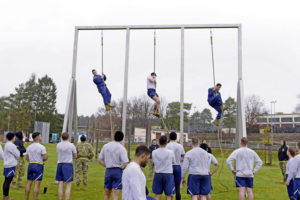
The 435th Security Forces Squadron hosted the U.S. Army Air Assault Assessment for the Kaiserslautern Military Community at the Rhine Ordnance Barracks, Nov. 18 and 19.
The candidates, from the 435 SFS, 52 SFS, 786th Civil Engineer Squadron, and 569th U.S. Forces Police Squadron, were tested on their physical and mental strength while completing an Army Physical Fitness Test, a 25-foot-high rope climb, and a 12-mile-long ruck march.
On the first day, Airmen completed the APFT which consists of push-ups, sit-ups and a two-mile run. After the APFT, they did the rope climb.
On the second day, Airmen assigned to the 435 SFS monitored the candidates during the ruck march, who had to carry at least 35 pounds of equipment and complete the 12-mile march in less than three hours.
“Candidates are not only facing physical but mental fortitude throughout the ruck march,” said U.S. Air Force Staff Sgt. Ulysses Ortiz, 435 SFS contingency response team leader.
The Air Assault Assessment is a step in the process of attending the Sabalauski Air Assault School in Fort Campbell, Ky., a 10-day course that prepares military members for insertion, evacuation and pathfinder missions.
The curriculum at the schoolhouse heavily focuses on rappelling techniques, sling load operations, and combat assault.
“This is a prep course, essentially,” Ortiz said. “They needed to do this assessment so they can gauge their abilities and if they want to go to the Army Air Assault schoolhouse.”

Once the Airmen pass, Air Assault qualified personnel assigned to the 435 SFS teach them everything they will see at the schoolhouse in Fort Campbell, such as inspecting loads, Humvees and trailers.
“For this course [at the schoolhouse], it will take somebody who not only has the mental fortitude, but the physical fortitude as well,” he said. “It is a very demanding course. The first day is nothing but physical exhaustion to make sure that you actually want to be there.”
Airmen increasing their combat capabilities is crucial to the 435 SFS because it adds skills outside of the usual airborne operations, Ortiz said.


